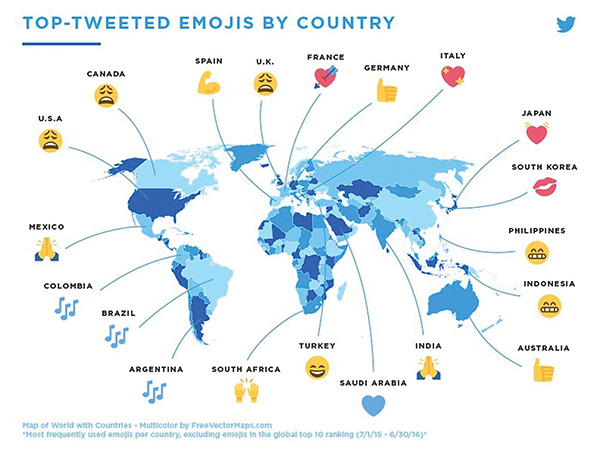Embrace the language of the future: Emoji
A report released by real-time emotional marketing platform Emogi attests that 92% of online consumers use emoji. According to Twitter, the most tweeted emoji in 2016 were ![]() , followed by
, followed by ![]() and
and ![]() . But Jeremy says that the most searched emoji in 2016 was the relatively new shrug
. But Jeremy says that the most searched emoji in 2016 was the relatively new shrug ![]() , the face with tears of joy
, the face with tears of joy ![]() and the heart
and the heart![]() .
.
 |
|
[Photo/Courtesy of Twitter] |
The usage of these ideograms differs across various countries and platforms. For example, a recent analysis of the "Emoji Usage of Smartphone Users" by scholars from Peking University says that in France, people are more likely to use emoji, with 19.8% of messages involving at least one. (The most frequently used emoji in the country is ![]() .) Russia and the US are following, but with as the most used emoji. On the other hand, on Twitter, the most tweeted emoji in France is
.) Russia and the US are following, but with as the most used emoji. On the other hand, on Twitter, the most tweeted emoji in France is ![]() , and Italy
, and Italy ![]() and Japan
and Japan ![]() share a similar love of the heart. As for the US, Canada and the UK, they just don't seem to be as happy.
share a similar love of the heart. As for the US, Canada and the UK, they just don't seem to be as happy.
The translation of emoji in different countries can also be a tricky thing. Burge explains that emoji use tends to fall into two categories: literal and figurative. "For instance, people in the US have started using the "WC" emoji to mean "woman crush" instead of its original meaning, "water closet" for the toilet/bathroom," he says.
Nowadays, the influence of emoji is everywhere – and brands and celebrities are all catching the wave. "I see a whole new industry rising out of the emoji phenomenon, with sideline merchandise such as manga, animation, stuffed animals, clothes and shoes," says Lin Zhang, a PhD candidate at the University of Southern California, whose expertise covers the politics, culture and economy of new-media technologies, "Sometimes it's hard to tell which comes first – the featured emoji or the sideline products. But the fact that people use those characters on a daily basis to express themselves definitely improves the 'stickiness' of those icons."
 |
|
[Photo/Courtesy of Karl Lagerfeld] |
There are celebrity emoji packs by Karl Lagerfeld (emotiKarl), Kim Kardashian (Kimoji), Justin Bieber (Justmoji) and Ellen DeGeneres (Ellen's Emoji Exploji), as well as branded emoji from Versace, Ikea and Harper's Bazaar. There's even Book from the Ground, an entire tome written in emoji by Chinese artist Xu Bing.
 |
|
[Photo/Courtesy of Versace] |
Where is emoji headed? "Far from replacing language, the visual symbols in fact enhance our ability to converse with one another – they also facilitate more effective communication," explains Vyv Evans in his article No, the Rise of Emoji Doesn't Spell the End of Language. On the other hand, according to Zhang, the future of mediated communication looks more like a combination of words and icons.
So are you ready to embrace the future of language?























